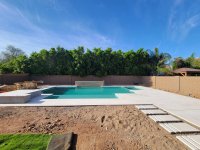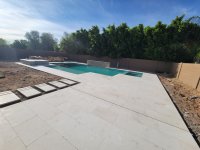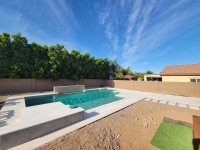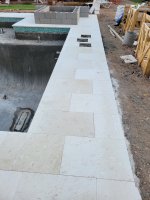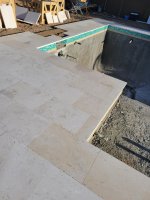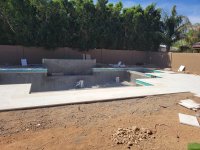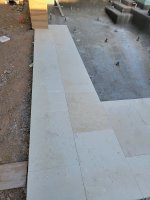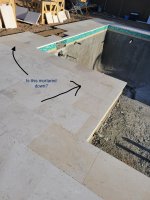Hello all! We recently completed our owner-builder pool/spa in the Phoenix area. I named her "La Dominicana" as the finish selection was inspired by a trip I took to the Dominican Republic. I sourced white limestone/shellstone from one of the larger suppliers here, purchased through a local retailer. The material is 3cm Mayra White/Freska Limestone in a 16x24 for both coping and decking. The stone retailer told me to have the pool coping laid with white thinset in between any mortar bed and the stone to prevent possible seepage of mortar/moisture/color up into the porous stone. I told the decking contractor that (along with many other specifications I requested that were ignored or brushed off until I repeatedly bothered them) but they refused to listen. They laid the coping over the bond beam with a standard grey mortar/thinset mixed combination - no grout joints and no separate layer of thinset. None of the coping was "back buttered" either, though I don't know that would be necessary or standard for a coping install? This contractor is licensed/bonded/insured, but is adamant they've done nothing wrong.
Long story short, the coping vs. decking field is a darker color (we're 3 weeks out from the day it was laid so it's all mostly cured), which I can only assume is from seepage into the stone from the grey mortar/thinset mix. The contractor says "this has never happened before" and blames the stone supplier/quality of the stone for discoloration, says the stone contains more iron and reacted with the mortar/thinset material. They came out and tried putting hydrogen peroxide on it, which I don't think did anything to the color at all. I guess they think it's oxidation, though the color to me doesn't seem rusty/orangy, it seems just "darker" to me. He also says the grout joints are not necessary and that I should not worry about pool coping popping off with this installation method of mortar/thinset mixed together vs. a separate layer of thinset in between mortar bed and the stone in general (whether white or not). Obviously the stone supplier is going to tell me they should've used white thinset to avoid the discoloration...
QUESTIONS:
1) Has anyone had this experience with discoloration of white limestone or other similar when laid directly over grey mortar/thinset?
2) I'm assuming there's little to be done to correct the color vs. ripping it up and having new material laid, but someone PLEASE PLEASE correct me if I'm wrong....?
3) Has anyone had travertine or other natural stone coping laid with mortar/thinset mixed together and nothing else? Any longevity issues?
4) Thoughts on no grout on coping, coupled with no separate thinset layer being used...should I be worried about water seeping into joints and loosening bond with the mortar/thinset mixture over time?
Clearly I'm not a tile/paver/coping installer but I have a few other installers that have "weighed in" and they say always use grout joints and always use thinset, and white in the case of a porous white stone.
ANY ADVICE APPRECIATED!!!!!!!!! And Thanks for reading my long post!
Thanks for reading my long post!
Long story short, the coping vs. decking field is a darker color (we're 3 weeks out from the day it was laid so it's all mostly cured), which I can only assume is from seepage into the stone from the grey mortar/thinset mix. The contractor says "this has never happened before" and blames the stone supplier/quality of the stone for discoloration, says the stone contains more iron and reacted with the mortar/thinset material. They came out and tried putting hydrogen peroxide on it, which I don't think did anything to the color at all. I guess they think it's oxidation, though the color to me doesn't seem rusty/orangy, it seems just "darker" to me. He also says the grout joints are not necessary and that I should not worry about pool coping popping off with this installation method of mortar/thinset mixed together vs. a separate layer of thinset in between mortar bed and the stone in general (whether white or not). Obviously the stone supplier is going to tell me they should've used white thinset to avoid the discoloration...
QUESTIONS:
1) Has anyone had this experience with discoloration of white limestone or other similar when laid directly over grey mortar/thinset?
2) I'm assuming there's little to be done to correct the color vs. ripping it up and having new material laid, but someone PLEASE PLEASE correct me if I'm wrong....?
3) Has anyone had travertine or other natural stone coping laid with mortar/thinset mixed together and nothing else? Any longevity issues?
4) Thoughts on no grout on coping, coupled with no separate thinset layer being used...should I be worried about water seeping into joints and loosening bond with the mortar/thinset mixture over time?
Clearly I'm not a tile/paver/coping installer but I have a few other installers that have "weighed in" and they say always use grout joints and always use thinset, and white in the case of a porous white stone.
ANY ADVICE APPRECIATED!!!!!!!!! And


